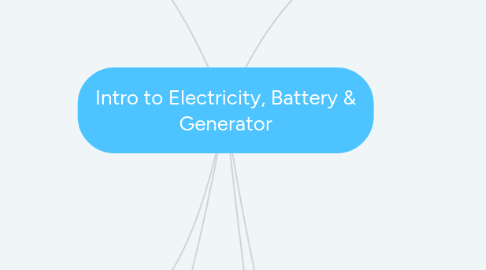
1. AC GENERATOR
1.1. How does a AC generator work
1.1.1. This will produce a magnetic field around the rotating element
1.1.2. A DC Source is supplied to the rotating Field coils
1.1.3. As the rotor is turned by the prime mover, the magnetic field will cut the conductors of the stationary armature, and the EMF will be induced into the armature windings
1.2. Household current is 230Volts 50Hz
1.3. USA household current is 130volts 60Hz
1.4. 3Phase Generator
1.4.1. Same principles as the single phase generator
1.4.2. 3 Equally-spaced winding and three output voltages
1.4.2.1. 120 degree out of phase
1.4.3. Star Connection
1.4.4. Delta Connection
2. Basic Electrical System
2.1. Electron Flow
2.1.1. Atoms
2.1.1.1. Composed of
2.1.1.1.1. Electrons
2.1.1.1.2. Protons
2.1.1.1.3. Neutron
2.1.2. Definition of electricity
2.1.2.1. Flow of electrons from one atom to another
2.2. Conductor and insulator
2.2.1. Conductor
2.2.1.1. Atoms with free electrons
2.2.1.1.1. Silver
2.2.1.1.2. copper
2.2.1.1.3. aluminum
2.2.2. Insulator
2.2.2.1. Few or no free electrons
2.2.2.1.1. Prevent flow of electron between conductor
2.2.2.1.2. Glass
2.2.2.1.3. rubber
2.2.2.1.4. porcelain
3. Basic automotive electrical system
3.1. Electrical circuit
3.1.1. complete circuit is needed to work
3.1.1.1. Power source
3.1.1.2. conductor
3.1.1.3. Load
3.2. Automobiles
3.2.1. Ground is provided by the frame
3.3. Electricity takes the path of least resistance
3.4. Control protection devices
3.4.1. Switches
3.4.2. Fuses
3.4.3. Circuit breaker
4. Introduction to electricity
4.1. SI UNITS
4.1.1. Charge
4.1.1.1. Coulomb
4.1.2. Current
4.1.2.1. Ampere
4.1.3. Voltage
4.1.3.1. Volt
4.2. Two types of Connection
4.2.1. Series
4.2.1.1. Addition of voltage in a series connection
4.2.1.2. Polarities matter
4.2.2. Parallel
4.2.2.1. Same Voltage but higher Current
4.3. V=IR
4.4. Resistor
4.4.1. Functions
4.4.1.1. Limiting current in electric circuit
4.4.1.2. Lowering voltage level
4.4.1.3. Current Provider
4.4.1.4. A sensor
4.4.2. Resistor can be made of
4.4.2.1. Carbon film
4.4.2.2. Carbon Composistion
4.4.2.3. Metal Oxide
4.4.2.4. Percision Metal film
4.4.3. Resistor Value= AB x 10c +- Tolerance %
4.4.4. Resistor colour code
4.4.4.1. Black x1
4.4.4.2. Brown x10
4.4.4.3. Red x100
4.4.4.4. Orange x1000
4.4.4.5. Yellow x10000
4.4.4.6. Green x100000
4.4.4.7. Blue x1000000
4.4.4.8. Purple x10000000
4.4.4.9. Grey x100000000
4.4.4.10. White x1000000000
4.4.4.11. Silver x.01
4.4.4.11.1. To calaulate resistance in parallel circuit
4.4.4.12. Gold x.1
4.4.5. Ohms
4.4.6. Variable resistor
4.4.6.1. To control the amount of current to flow through the load
4.5. Capacitor
4.5.1. Is an energy storage element
4.5.2. Connected in parallel in a dc circuit
4.6. Diodes
4.6.1. Allow electricity to flow in one direction
4.6.2. Transistor
4.6.2.1. Electronic relay
4.6.2.1.1. Resists electrical flow or allow a predetermined amount of current to flow
5. Electromagnetism
5.1. The current magnetizes the iron core and creates a pair of magnetic poles
6. Batteries
6.1. Functions
6.1.1. Store power only
6.1.2. Provides power for starting
6.1.3. Supply power when demand is greater that alternator output
6.1.4. Stabilize system voltage
6.2. Terms
6.2.1. Battery
6.2.1.1. A device that stores electricity
6.2.2. Battery cell
6.2.2.1. Consists of Negative and Positive Plates
6.2.3. Battery Cycling
6.2.3.1. Repeated charging and discharging events
6.2.4. Battery plates
6.2.4.1. Made of lead and lead oxide
6.2.5. Charging
6.2.5.1. Current flowing int o the battery from the charging system
6.2.6. Discharging
6.2.6.1. Current flowing out of the battery
6.3. Electrolyte
6.3.1. A mixture of sulfuric acid and distilled water
6.3.1.1. 25% Sulfuric acid
6.3.1.2. 75% distilled water
6.4. Battery Products
6.4.1. Voltage
6.4.2. Direct Current
6.4.3. Hydrogen Gas
6.5. Modern Vehicles
6.5.1. 12.6Volt
6.5.2. Hybrid vehicles 144-270 volt

